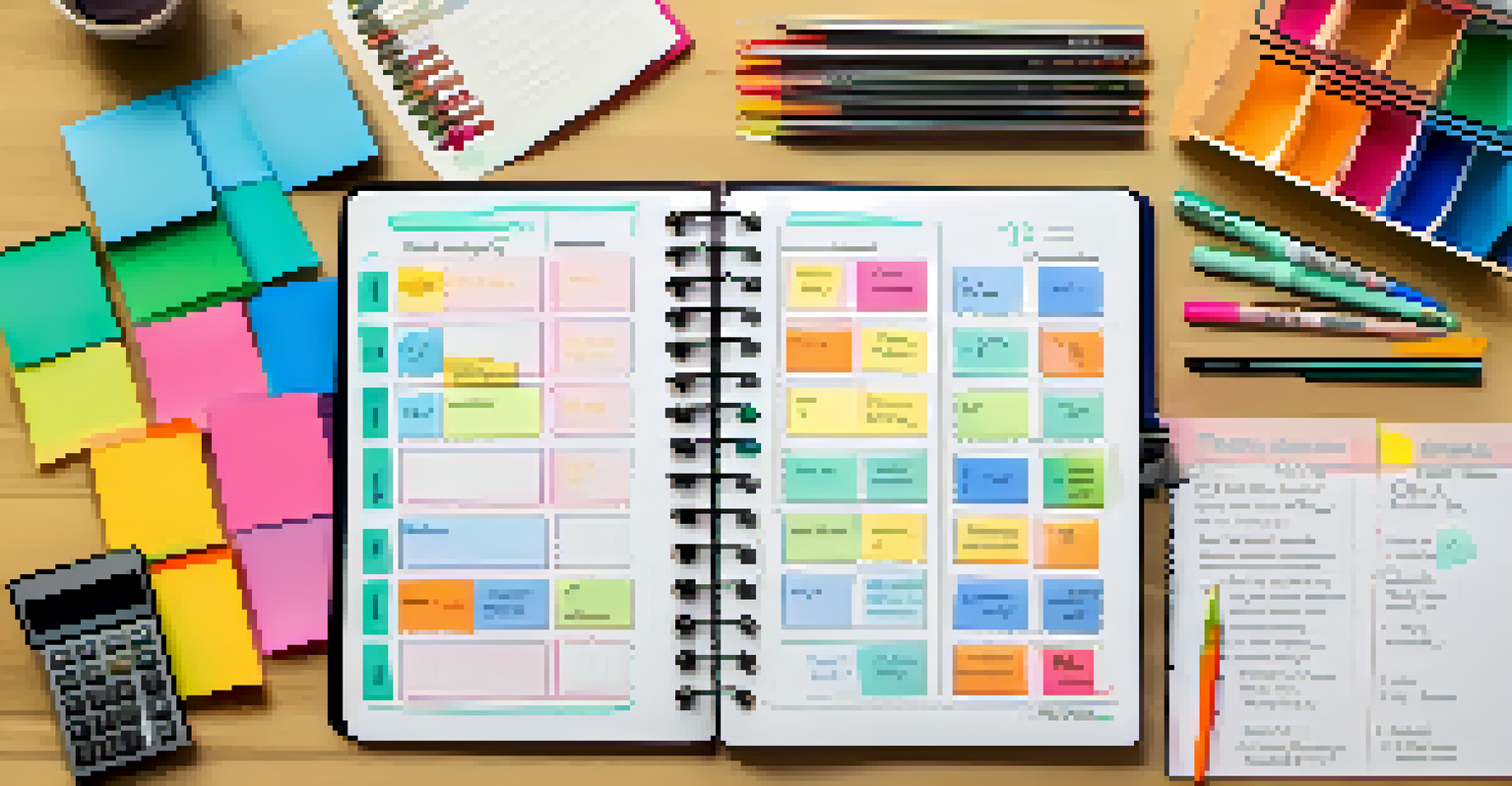Understanding Cash Flow Management for Personal Finances

What is Cash Flow Management in Personal Finance?
Cash flow management is the process of tracking your income and expenses to ensure you have enough funds for your needs. Imagine it as keeping an eye on the flow of a river; just as you need to know when the water is high or low, you must monitor your finances to avoid droughts or floods in your budget. This practice helps you maintain stability in your financial life, ensuring you can meet your obligations and save for the future.
Beware of little expenses; a small leak will sink a great ship.
By understanding your cash flow, you can identify patterns in your spending and uncover areas where you might be overspending. This awareness allows you to make informed decisions about saving, investing, or even cutting back on certain expenses. Essentially, it’s like having a roadmap that guides you through your financial journey, helping you navigate toward your goals.
In summary, cash flow management is about balancing the money coming in and going out. It ensures that you have control over your finances and helps you plan for unexpected expenses. Just like a well-planned trip, having clarity on your cash flow will help you reach your destination with fewer bumps along the way.
The Importance of Tracking Your Income and Expenses
Tracking your income and expenses is the cornerstone of effective cash flow management. By keeping a detailed record of where your money comes from and where it goes, you can see the bigger picture of your financial health. Think of it like a detective gathering clues; without this information, it's challenging to solve the mystery of your spending habits.

There are various tools available to help you track your finances, from simple spreadsheets to sophisticated budgeting apps. Each method has its benefits, but the key is to find one that fits your lifestyle and preferences. For example, if you enjoy using your smartphone, an app might be more convenient, whereas a spreadsheet might work better for someone who prefers a hands-on approach.
Understanding Cash Flow Management
Cash flow management involves tracking income and expenses to maintain financial stability and reach future goals.
Ultimately, tracking your income and expenses empowers you to make better financial decisions. It allows you to spot trends and adjust your budget accordingly, ensuring that you’re not living beyond your means. With this clarity, you can prioritize your spending, save for important goals, and reduce financial stress.
Creating a Realistic Budget for Cash Flow Management
A realistic budget is essential for effective cash flow management. It acts as a financial blueprint, guiding you on how much to spend and save each month. Picture it as a diet plan; just as you wouldn’t want to drastically cut calories, you should create a budget that feels sustainable and achievable, not overly restrictive.
A budget is telling your money where to go instead of wondering where it went.
To create a budget, start by calculating your total income and listing your fixed and variable expenses. Fixed expenses include things like rent or mortgage payments, while variable expenses can fluctuate, such as dining out or entertainment. By categorizing your expenses, you gain clarity on where your money is going and where you might be able to cut back.
Once you have a clear picture, set realistic spending limits for each category. Remember, the goal is not to deprive yourself but to find a balance that allows you to enjoy life while also saving for the future. A well-structured budget can help you live within your means and ensure that your cash flow remains healthy.
The Role of Emergency Funds in Cash Flow Management
An emergency fund is a crucial safety net in cash flow management, providing peace of mind during unexpected events. Think of it as a financial cushion that absorbs shocks, like a soft landing after a sudden fall. Having this fund can prevent you from relying on credit cards or loans when unforeseen expenses arise, such as car repairs or medical bills.
A common recommendation is to save at least three to six months' worth of living expenses in your emergency fund. This may seem daunting, but starting small and building gradually can make it more manageable. For instance, set a monthly savings goal that fits your budget, and watch your fund grow over time with consistent contributions.
The Need for Emergency Funds
An emergency fund acts as a financial cushion, enabling you to handle unexpected expenses without relying on credit.
Incorporating an emergency fund into your cash flow management strategy not only protects you from financial setbacks but also allows you to make more confident financial decisions. With a cushion in place, you can focus on your long-term goals without the constant worry of unexpected expenses derailing your plans.
How to Reduce Unnecessary Expenses
Reducing unnecessary expenses can significantly improve your cash flow management. It’s like cleaning out your closet; once you remove items you no longer need, you create space for what truly matters. By identifying and cutting back on non-essential spending, you can free up money for savings or investments.
Start by reviewing your spending habits over the past few months. Look for patterns where you might be overspending, such as dining out too often or subscribing to services you rarely use. Once you identify these areas, consider alternatives, like cooking at home more frequently or sharing subscriptions with friends.
Implementing these changes can have a profound impact on your finances. Even small adjustments can accumulate over time, significantly improving your cash flow. By being mindful of your expenses, you can prioritize what truly enhances your life and cut back on what doesn’t.
The Importance of Regularly Reviewing Your Cash Flow
Regularly reviewing your cash flow is essential to maintain financial health. Just as you would check the oil in your car or monitor your health, keeping an eye on your finances ensures that everything is running smoothly. This practice helps you stay aware of changes in your spending and income, allowing you to make timely adjustments as needed.
Set aside time each month to review your budget, income, and expenses. Look for trends, such as rising costs in certain categories or fluctuations in your income. This proactive approach enables you to address potential issues before they become significant problems, much like spotting a small leak before it turns into a burst pipe.
Regularly Review Your Finances
Consistently reviewing your cash flow helps you identify trends and make timely adjustments to stay on track financially.
By making this review a routine part of your financial management, you cultivate a deeper understanding of your cash flow. This awareness empowers you to make informed decisions, adapt to changes, and ultimately achieve your financial goals with confidence.
Setting Financial Goals to Enhance Cash Flow Management
Setting financial goals is a powerful way to enhance your cash flow management. These goals act as a roadmap, guiding your spending and saving decisions toward achieving specific outcomes. Think of them as the stars in the night sky; they provide direction and help you navigate through the complexities of personal finance.
Begin by defining both short-term and long-term financial goals. Short-term goals might include saving for a vacation, while long-term goals could involve retirement or purchasing a home. By clearly outlining these objectives, you create a sense of purpose in your financial journey, making it easier to prioritize your cash flow management efforts.

As you work toward your goals, regularly assess your progress and make adjustments as needed. This dynamic approach not only keeps you motivated but also reinforces the importance of maintaining healthy cash flow. With your goals in sight, you'll be better equipped to manage your finances and make decisions that align with your aspirations.